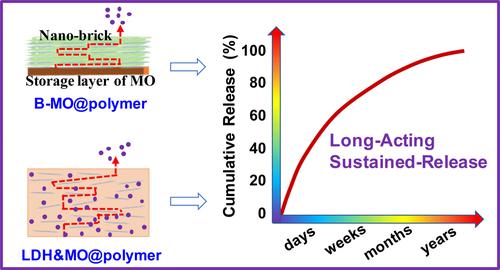当前位置:
X-MOL 学术
›
Polym. Compos.
›
论文详情
Our official English website, www.x-mol.net, welcomes your feedback! (Note: you will need to create a separate account there.)
Long‐acting release of small molecules achieved by barrier effect of nano‐brick
Polymer Composites ( IF 5.2 ) Pub Date : 2024-03-20 , DOI: 10.1002/pc.28335 Guohong Shen 1 , Biao Li 1 , Jian Zhang 1 , Lan Jin 1 , Qiang Tian 2 , Zeya Yang 1 , Kai‐Jie Wang 3 , Jingbin Han 1, 4
2 for MO and display long‐acting sustained‐release property arising from the barrier effect of LDH nano‐brick. Specifically, for the B‐MO@polymer film, the release time of 50% MO is 10 days and the release time of 80% MO can be extended to 30 days. Ultimately, the time for complete release (>96%) reaches over 60 days. By using LDH‐embedded polymer as carriers for active molecules, the zero‐order release of MO was realized for LDH&MO@polymer films, achieving sustained release within as long as 145 days. This work provides a new paradigm to achieve the long‐acting sustained‐release of active molecules through the barrier effect of 2D nano‐bricks.Highlight Two types of films were obtained to achieve long‐term release of small molecules. The films show high loading capacities for active molecules. The long‐acting property is derived from the barrier effect of 2D nano‐brick. The films can be produced in a large scale and have good application prospects.
中文翻译:

利用纳米砖的屏障效应实现小分子的长效释放
活性分子的长效缓释在化工生产、食品防腐、体内药物输送等方面具有重要意义。然而,缓释材料普遍存在初始爆发释放和释放时间短(以菲克低点为主)的问题。在此,我们设计并制造了两种类型的薄膜材料,以甲基橙(MO)作为目标释放物质,实现小分子的缓慢、连续和长期释放。 B-MO@聚合物薄膜是通过将MO嵌入聚乳酸/聚乙二醇(PLA/PEG)基材中,然后在基材表面组装层状双氢氧化物(LDH)/羧甲基壳聚糖(CMC)阻挡层而获得的。另一种类型的薄膜(LDH&MO@polymer)是通过将LDH和MO共混到PLA/PEG聚合物基质中而制备的。这些薄膜显示出约 500 μg/cm 的高负载能力2 MO 并显示出由于 LDH 纳米砖的屏障效应而产生的长效缓释特性。具体来说,对于B-MO@聚合物薄膜,50%MO的释放时间为10天,80%MO的释放时间可延长至30天。最终完全释放(>96%)的时间达到60天以上。通过使用LDH嵌入聚合物作为活性分子的载体,LDH&MO@聚合物薄膜实现了MO的零级释放,实现了长达145天的持续释放。该工作为通过二维纳米砖的屏障效应实现活性分子的长效缓释提供了新的范例。 获得了两种类型的薄膜来实现小分子的长期释放。 这些薄膜对活性分子表现出高负载能力。 长效特性源自二维纳米砖的屏障效应。 该薄膜可大规模生产,具有良好的应用前景。
更新日期:2024-03-20
Polymer Composites ( IF 5.2 ) Pub Date : 2024-03-20 , DOI: 10.1002/pc.28335 Guohong Shen 1 , Biao Li 1 , Jian Zhang 1 , Lan Jin 1 , Qiang Tian 2 , Zeya Yang 1 , Kai‐Jie Wang 3 , Jingbin Han 1, 4
Affiliation

|
中文翻译:

利用纳米砖的屏障效应实现小分子的长效释放



























 京公网安备 11010802027423号
京公网安备 11010802027423号